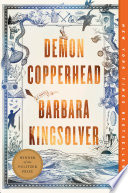The pairing of "Demon Copperhead" by Barbara Kingsolver with Slow Cooker Chicken Creole and a classic Sazerac cocktail creates an immersive cultural experience. Both the book and the dish draw inspiration from Southern traditions, with "Demon Copperhead" exploring contemporary Appalachian life, and Chicken Creole showcasing New Orleans flavors. The bold spices of the Chicken Creole match the rich, complex flavors of the Sazerac, a drink as storied as the city itself. This combination provides a multisensory exploration of Southern culture, perfect for a literary and culinary journey.

Ingredients
- 1 1/2 pounds boneless, skinless chicken breasts or thighs
- 1 tablespoon olive oil
- 1 large onion, chopped
- 1 green bell pepper, chopped
- 1 red bell pepper, chopped
- 3 cloves garlic, minced
- 1 can (14.5 ounces) diced tomatoes, undrained
- 1 can (8 ounces) tomato sauce
- 1 tablespoon tomato paste
- 1 teaspoon paprika
- 1 teaspoon dried thyme
- 1/2 teaspoon dried oregano
- 1/4 teaspoon cayenne pepper (adjust for heat preference)
- 1 teaspoon salt
- 1/2 teaspoon black pepper
- 1 teaspoon sugar
- 1/2 cup chicken broth
- 1 bay leaf
- 1 tablespoon Worcestershire sauce
- 2 green onions, chopped (for garnish)
- Fresh parsley, chopped (for garnish)
- Cooked white rice, for serving
Instructions
- Prepare the Chicken: Season the chicken breasts or thighs with a pinch of salt and black pepper. Heat the olive oil in a large skillet over medium-high heat. Sear the chicken for 2-3 minutes on each side until lightly browned. Transfer the chicken to the slow cooker.
- Sauté the Vegetables: In the same skillet, add the chopped onion, green bell pepper, red bell pepper, and minced garlic. Sauté for 4-5 minutes until the vegetables are softened. Transfer the sautéed vegetables to the slow cooker with the chicken.
- Mix the Sauce: In the slow cooker, add the diced tomatoes, tomato sauce, tomato paste, paprika, thyme, oregano, cayenne pepper, salt, black pepper, sugar, chicken broth, bay leaf, and Worcestershire sauce. Stir everything together to combine.
- Cook the Chicken Creole: Cover the slow cooker and cook on low for 6-7 hours or on high for 3-4 hours, until the chicken is tender and cooked through. If the sauce is too thin, you can remove the lid for the last 30 minutes of cooking to allow it to thicken.
- Serve: Remove the bay leaf and discard it. Transfer the chicken to a serving platter, spoon the sauce over the top, and garnish with chopped green onions and fresh parsley. Serve the Chicken Creole over a bed of cooked white rice.
Demon Copperhead

"Demon Copperhead" is the brilliant reinvention of "David Copperfield" by the ever-talented Barbara Kingsolver. Set in the mountains of modern-day Southern Appalachia, the story follows a young man's journey through hardship, hope, and resilience.
WINNER OF THE PULITZER PRIZE • WINNER OF THE WOMEN'S PRIZE FOR FICTION New York Times Readers’ Pick: Top 100 Books of the 21st Century • An Oprah’s Book Club Selection • An Instant New York Times Bestseller • An Instant Wall Street Journal Bestseller • A #1 Washington Post Bestseller • A New York Times "Ten Best Books of the Year" "Demon is a voice for the ages—akin to Huck Finn or Holden Caulfield—only even more resilient.” —Beth Macy, author of Dopesick "May be the best novel of [the year]. . . . Equal parts hilarious and heartbreaking, this is the story of an irrepressible boy nobody wants, but readers will love.” —Ron Charles, Washington Post From the acclaimed author of The Poisonwood Bible and The Bean Trees, a brilliant novel that enthralls, compels, and captures the heart as it evokes a young hero’s unforgettable journey to maturity Set in the mountains of southern Appalachia, Demon Copperhead is the story of a boy born to a teenaged single mother in a single-wide trailer, with no assets beyond his dead father’s good looks and copper-colored hair, a caustic wit, and a fierce talent for survival. Relayed in his own unsparing voice, Demon braves the modern perils of foster care, child labor, derelict schools, athletic success, addiction, disastrous loves, and crushing losses. Through all of it, he reckons with his own invisibility in a popular culture where even the superheroes have abandoned rural people in favor of cities. Many generations ago, Charles Dickens wrote David Copperfield from his experience as a survivor of institutional poverty and its damages to children in his society. Those problems have yet to be solved in ours. Dickens is not a prerequisite for readers of this novel, but he provided its inspiration. In transposing a Victorian epic novel to the contemporary American South, Barbara Kingsolver enlists Dickens’ anger and compassion, and above all, his faith in the transformative powers of a good story. Demon Copperhead speaks for a new generation of lost boys, and all those born into beautiful, cursed places they can’t imagine leaving behind.
Discussion Questions
- How does the setting of Southern Appalachia influence the main character's journey?
- In what ways does Kingsolver draw on the themes of Dickens' "David Copperfield"?
- Discuss the role of family, both chosen and biological, in Demon Copperhead's life.
- How does the story address social and economic challenges of the Appalachian region?
- What is the significance of the protagonist's nickname "Demon"?
- How do the characters' personal struggles mirror larger societal issues?
- Discuss the author's use of dialect and narrative style in the novel.
- How does Demon Copperhead's resilience affect those around him?
- What role does education play in the lives of the characters?
- How does Kingsolver challenge stereotypes of the Appalachian community?
Authors:
Barbara Kingsolver
ISBN: 0063251922
Publisher: HarperCollins
Published Date: 2022-10-18
ISBN: 0063251922
Publisher: HarperCollins
Published Date: 2022-10-18
Sazerac

The Sazerac is a classic cocktail hailing from New Orleans, often considered one of the oldest American cocktails. It combines rye whiskey with bitters, sugar, and a hint of absinthe, served straight up in a chilled glass with a lemon twist.
Ingredients
- 2 ounces rye whiskey
- 1 sugar cube
- 2 dashes Peychaud's Bitters
- 1 dash Angostura bitters
- Absinthe, to rinse the glass
- Lemon peel, for garnish
Instructions
- Chill an old-fashioned glass by filling it with ice.
- In a separate mixing glass, muddle the sugar cube with the bitters until the sugar is dissolved.
- Add the rye whiskey to the mixing glass with a few ice cubes and stir until well-chilled.
- Discard the ice from the chilled glass and rinse the glass with a small amount of absinthe, discarding any excess.
- Strain the whiskey mixture into the absinthe-rinsed glass.
- Twist a lemon peel over the drink to express the oils and garnish, discarding the peel afterward.